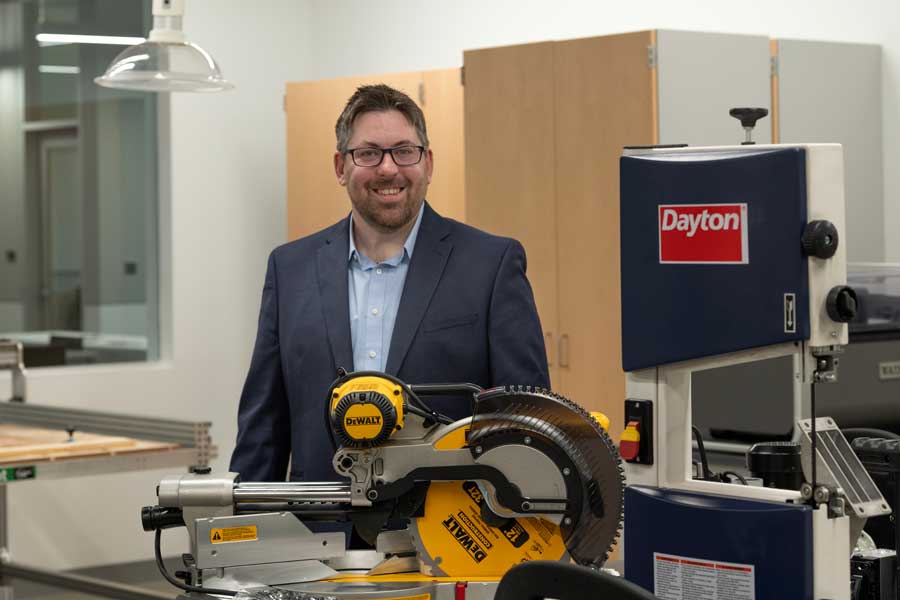Straus helps students explore creative uses of technology
‘We can create almost anything in here’

Aaron Straus, the University of Pittsburgh at Bradford’s new creative engineering coordinator, will tell you he has the coolest job on campus.
Straus oversees premium space in the university’s new George B. Duke Engineering and Information Technologies Building, which is home to a makerspace, machine shop and projects lab containing equipment ranging from a T-shirt press to a plasma cutter that can cut intricate designs in metal plates and sheet metal as easily as mom’s sewing shears shape a paper snowflake.
He knows how to use the equipment and is now teaching pretty much everyone he can meet. For that, he’s added another machine to his office – an espresso maker.
On a recent evening, over a dozen students gathered in the makerspace, some helping each other sew and hem garments for the winter formal, others learning how to use some of the space’s 3D printers. Instead of using ink, these “printers” layer materials ranging from biodegradable plastic to carbon fiber to create three-dimensional models. Engineering students can use these printers to create prototypes of their designs. A circuit board printer, soldering station and laser engraver give students even more options.
It feels quiet, peaceful and creative when two more students arrive and begin checking out some of the items that other students have been working on – a wooden laser-engraved pinball machine with 3D-printed paddles that lights up when the steel ball crosses copper strips, a fully functioning 3D-printed miniature automotive robot with wiring, a xylophone made from cut copper pipes and the beginnings of a laser tag set.
“Professor Straus invited us for coffee,” one of the new arrivals says. While Straus makes them mocha and latte in his office, he tells them about all of the things they can do and use in the new makerspace.
“We can create almost anything in here,” Straus says, from anatomical models to props for a play. Or even just fun stuff. 3D-printed characters are popular. “We don’t want this to be just for engineering students. We want to teach and engage the campus’s art, English, history and business disciplines.”
Adjacent to the makerspace is a full machine shop. Here students can work with metal – welding, filing, polishing, turning on five-axle lathes and cutting with the plasma cutter.
A final space in the creator area includes saws, routers, drill presses and belt grinders as well as space for students to work in teams on large projects, such as an envisioned Society of Automotive Engineers’ Baja car competition vehicle.
Straus is the rare educator who is experienced with the technical equipment and the creative arts. Prior to joining the Pitt-Bradford staff in January, he led the science and technology program at Salamanca (N.Y.) City Central School District, where each of the district’s schools have been recognized as a School of Excellence by the International Technology and Engineering Educators Association.
“That program was my baby,” he said, “but I’d always been interested in higher education.” After seeing an ad for the Pitt-Bradford position, Straus read about Pitt-Bradford’s new engineering technology degrees and the Duke Building. It impressed him.
“I think these programs and building are going to put Pitt-Bradford on the map,” he said. “There has been a big gap in engineering in this region.”
While he often boasts that he can teach a kindergartener to use any piece of equipment in the makerspace, he said, “Working with the college engineering students has been a delight.”
Straus has recruited and is teaching a team of student workers to help run the labs. Students are writing standard operation procedure manuals for each piece of equipment using manufacturers’ manuals, industry training books and regulations from the U.S. Occupational Safety and Health Administration.
Students will be certified to use each piece of equipment. Once they are certified on all of the equipment in a particular lab, they will be able to access the lab outside of its normal hours of operation.
In addition to overseeing the labs, Straus teaches courses in Computer Aided Design, Engineering Design and Special Topics: Machine Safety. He has also been kept busy giving tours for groups that include donors to the building, high school guidance counselors, area manufacturers and the Pitt-Bradford community.
Some faculty followed up on their tours quickly with requests for special projects such as cutting glass tubes for science labs. Orin James, assistant professor of biology, is returning with his students for a printing project.
Straus’s own education and background made him an ideal candidate for this new staff position. In addition to several industry and education certifications, he holds a Master of Advanced Study degree in integrated physics, a Master of Education degree in educational technology and undergraduate degrees in art, English and engineering technology.
When he is not on campus, Straus enjoys exploring trails and streams around his home with his wife, Julie, and their five children.
--30--